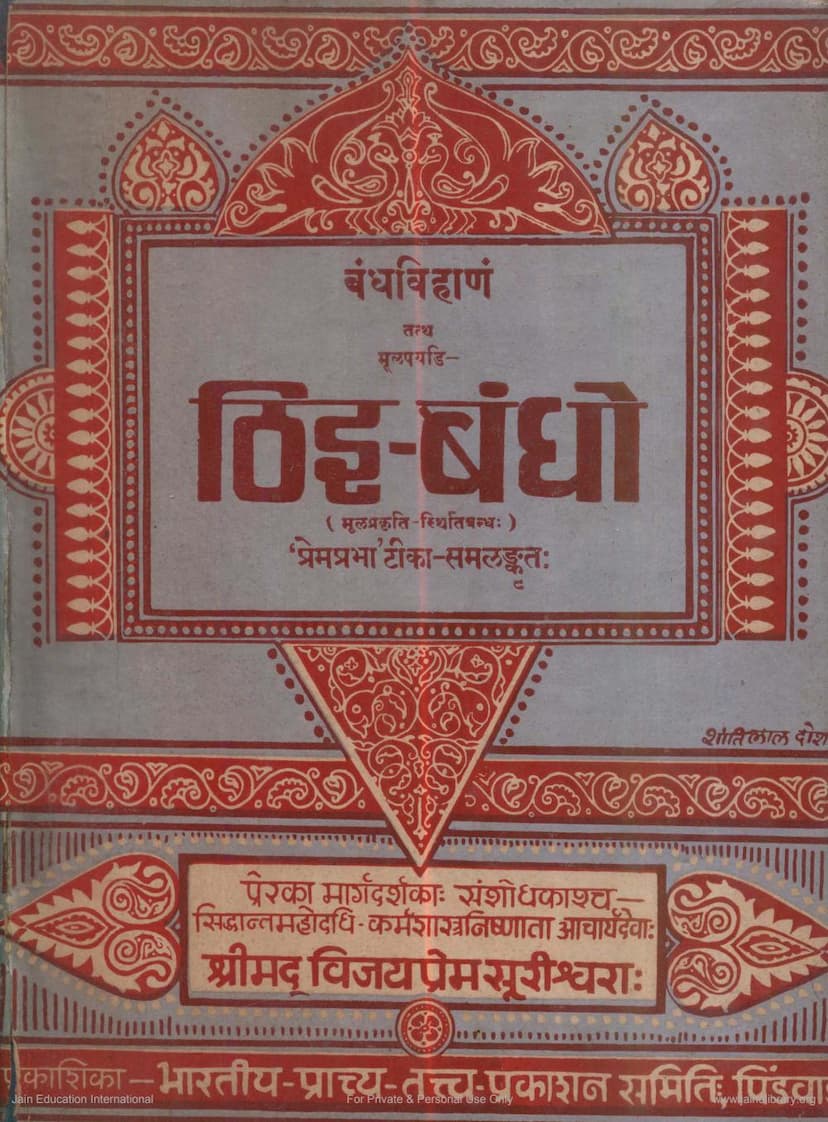Thiaibandho
Added to library: September 2, 2025

Summary
The Jain text "Bandha Vihāṇaṁ: Mūlapayaḍiṭhi Bandho," authored by Prem Sūri, published by Bhāratīya Prācyatattva Prakāśan Samiti, and featuring the commentary "Prema Prabhā," is a comprehensive treatise on the intricate concepts of karma in Jain philosophy. The provided text highlights the second volume of the Acharyadeva Shrimad Vijay Premasurishwara-Karma Sahitya-Jain Granthamala series.
Core Subject Matter:
The central theme of the book revolves around Bandha Vihāna, specifically focusing on Mūla Prakṛti Sthiti Bandha. This translates to the "Law of Bondage" and the "Bondage of Fundamental Karmic Essences, specifically the aspect of Duration (Sthiti Bandha)." In Jainism, karma is understood as a subtle matter that adheres to the soul, obscuring its innate qualities. These karmas are classified into various types based on their nature, duration, intensity, and object.
The text delves into the detailed analysis of how these karmas bind to the soul, particularly focusing on the Sthiti Bandha, which refers to the duration for which a particular karma remains attached to the soul. This duration is influenced by various factors, including the soul's internal dispositions (bhava), external circumstances, and the specific nature of the karma itself.
Key Concepts and Structure:
The book, along with its detailed commentary "Prema Prabha," meticulously explains:
- Mūla Prakṛti (Fundamental Karmic Essences): Jainism categorizes karma into eight fundamental types (Mūla Prakṛti), which are further divided into numerous sub-types (Uttara Prakṛti). The text likely details these fundamental types and their characteristics.
- Sthiti Bandha (Duration of Karmic Bondage): This is the primary focus, exploring how the duration of karma's attachment is determined. It involves understanding the factors influencing the "time period" of the karmic effect.
- Anuyoga Dvāras (Categories of Analysis): Jain scriptures often analyze concepts through various lenses or categories called Anuyoga Dvāras. The text likely employs these categories to dissect the Sthiti Bandha, such as:
- Sattapada (Presence): Whether a particular karma is present or not.
- Svāmitva (Authorship/Ownership): Who is responsible for the karmic bondage.
- Sādi-Anādi (Beginning and Beginningless): Whether the bondage has a beginning or is eternal.
- Kāla (Time): The duration of the bondage.
- Antara (Interval): The time gap between successive bondages of the same karma.
- Saṃnikarṣa (Contiguity/Association): The association of different karmas.
- Bhaṅgsaṁkhyā (Counting of Modes/Variations): The classification of different types of bondages.
- Bhāga (Portion/Share): The share of karma in different situations.
- Kṣetra (Place/Space): The location or space relevant to the bondage.
- Sparśanā (Touch/Contact): The nature of contact or interaction with karmic matter.
- Pariṇāma (Consequence/Result): The outcome of the karmic bond.
- Pramāṇa (Quantity): The measure or extent of the bondage.
- Upayoga (Application/Usage): The mode of consciousness involved in the bondage.
- Mārgāṇā (Conditions/Paths): The text likely analyzes these concepts in relation to the various states of existence and consciousness in Jainism, such as different types of souls (e.g., souls in different sensory categories, souls in different states of consciousness, souls in different species like human, animal, celestial, hellish beings), karmic influx based on passions (kashaya), and the stages of spiritual development (guna sthanas).
- Vividha Bandha (Various Types of Bondage): The book would explore different ways karmas bind to the soul, including Prakṛti Bandha (bondage based on the quality of karma), Sthiti Bandha (duration), Rasa Bandha (intensity of taste/experience), and Pradesha Bandha (quantity of karmic matter).
Commentary "Prema Prabha":
The inclusion of the "Prema Prabha" commentary by Muni Jagachandravijaya signifies a detailed and expansive explanation of the original text ("Mūla Gāthā"). This commentary likely clarifies the complex philosophical and technical terms, provides examples, and elaborates on the scriptural references, making the profound teachings of Jain karma theory accessible to the reader.
Author and Publisher:
The author, Prem Sūri, and the publisher, Bhāratīya Prācyatattva Prakashan Samiti, indicate a focus on scholarly and traditional Jain texts aimed at preserving and disseminating knowledge within the Jain tradition. The inspiration and guidance from Acharya Shrimad Vijaya Premasurishwara emphasize the authoritative nature of the work within the Karma Shastra lineage.
Overall Significance:
This work is a crucial resource for serious students of Jainism, particularly those interested in the detailed mechanics of karma. It provides a systematic and profound understanding of how karmic forces operate, influencing the soul's journey through the cycle of rebirth and ultimately guiding towards liberation (moksha). The emphasis on Sthiti Bandha highlights the Jain understanding of the temporal aspect of karma and its impact on the soul's experiences in the worldly existence.